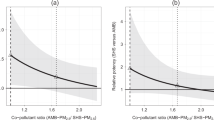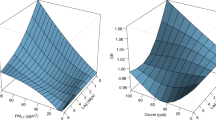Abstract
The effects of long-term exposure to air pollution on respiratory symptoms and respiratory hospitalization (for asthma, bronchitis or pneumonia) were assessed in a cross-sectional study of children (ages 7–11 years, N=667) living in a moderately industrialized city in Central Slovakia. Individual health, residence and family history data obtained through the CESAR study were coupled, using Geographic Information System (GIS) technologies, with total suspended particulate (TSP) exposure estimates derived from dispersion modeling of almost all local stationary sources. These data were used to assess, at the intra-city level and child-specific level, the potential for TSP as a risk factor for respiratory disease in children. TSP, PM10, and PM2.5 monitored ambient concentrations are highly correlated in the study location. Modeled TSP concentrations resulting from local source emissions are dominated by a large wood processing facility, suggesting variation in exposures among children. The prevalence of respiratory non-asthmatic symptoms and hospitalizations was associated with increased TSP. No association between long-term exposure to TSP and asthma diagnosis or wheeze symptoms was found. Logistic regression modeling indicated a significant increase in hospital admissions for asthma, bronchitis or pneumonia associated with increasing air pollution (OR 2.16, CI, 1.01–4.60), doctor-diagnosed bronchitis (OR 1.53, CI, 1.02–2.30), and parent-reported chronic phlegm (OR 3.43, CI, 1.64–7.16), expressed as odds for a 15 μg/m3 increase in estimated TSP exposure, and these increases are not due to differences in socio-economic, health care or other identified factors.
This is a preview of subscription content, access via your institution
Access options
Subscribe to this journal
Receive 6 print issues and online access
$259.00 per year
only $43.17 per issue
Buy this article
- Purchase on Springer Link
- Instant access to full article PDF
Prices may be subject to local taxes which are calculated during checkout
Similar content being viewed by others
Author information
Authors and Affiliations
Corresponding author
Additional information
Disclaimer: The information in this document has been funded wholly (or in part) by the U.S. Environmental Protection Agency. It has been subjected to review by the National Health and Environmental Effects Research Laboratory and approved for publication. Approval does not signify that the contents reflect the views of the Agency, nor does mention of trade names or commercial products constitute endorsement or recommendation for use.
Rights and permissions
About this article
Cite this article
HRUBÁ, F., FABIÁNOVÁ, E., KOPPOVÁ, K. et al. Childhood respiratory symptoms, hospital admissions, and long-term exposure to airborne particulate matter. J Expo Sci Environ Epidemiol 11, 33–40 (2001). https://doi.org/10.1038/sj.jea.7500141
Received:
Accepted:
Published:
Issue Date:
DOI: https://doi.org/10.1038/sj.jea.7500141
Keywords
This article is cited by
-
Personal child and mother carbon monoxide exposures and kitchen levels: Methods and results from a randomized trial of woodfired chimney cookstoves in Guatemala (RESPIRE)
Journal of Exposure Science & Environmental Epidemiology (2010)
-
Geographic variations of childhood asthma hospitalization and outpatient visits and proximity to ambient pollution sources at a U.S.-Canada border crossing
International Journal of Health Geographics (2005)
-
A review and evaluation of intraurban air pollution exposure models
Journal of Exposure Science & Environmental Epidemiology (2005)



